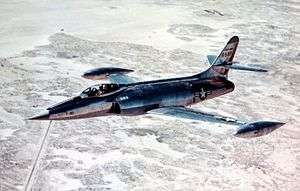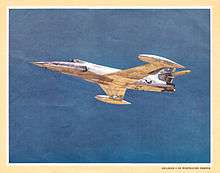Lockheed XF-90
| XF-90 | |
|---|---|
 | |
| XF-90 in flight | |
| Role | Fighter |
| Manufacturer | Lockheed |
| First flight | 3 June 1949 |
| Status | Canceled |
| Number built | 2 |
| Unit cost |
US$5.1 million for the program[1] |
The Lockheed XF-90 was built in response to a United States Air Force requirement for a long-range penetration fighter and bomber escort. The same requirement produced the McDonnell XF-88 Voodoo. Lockheed received a contract for two prototype XP-90s (redesignated XF-90 in 1948). The design was developed by Willis Hawkins and the Skunk Works team under Kelly Johnson. Two prototypes were built (s/n 46-687 and -688). Developmental and political difficulties delayed the first flight until 3 June 1949, with Chief Test Pilot Tony LeVier at the controls. Performance of the design was considered inadequate due to being underpowered, and the XF-90 never entered production.
Design and development

In response to a 1945 Army request for an advanced jet fighter, Lockheed proposed a jet powered initially by a Lockheed L-1000 axial flow turbojet, and then the General Electric J35.[2] Further design refinements included using two Westinghouse J34 engines with afterburners. After data showed that a delta planform would not be suitable, the Lockheed Model 90 was built as a mockup in 1947 with swept wings.[3]
The final design embodied much of the experience and shared the intake and low-wing layout of the previous P-80 Shooting Star, but with 35° sweptback wings, a sharply-pointed nose and two Westinghouse J34-WE-11 axial-flow turbojet engines, providing a total thrust of 6,200 lbf (27.6 kN),mounted side-by-side in the rear fuselage and fed by side-mounted air intakes.[4] The wings had leading edge slats, Fowler flaps and ailerons on the trailing edge. The pressurized cockpit was fitted with an ejector seat and a bubble canopy. Proposed armament was six 20 mm (.79 in) cannons. The internal fuel was supplemented by wingtip-mounted tanks, bringing total fuel capacity to 1,665 gal (6,308 l). The use of 75ST aluminum rather than the then-standard 24ST aluminum alloy, along with heavy forgings and machined parts, resulted in an extremely well-constructed and sturdy airframe. However, these innovations also resulted in an aircraft which had an empty weight more than 50 percent heavier than its competitors.[4]
The first XF-90 used J34s without afterburning, but these lacked the thrust for takeoff as rocket-assisted RATO were required for most of the first flights unless it carried a very low fuel load. The second (XF-90A) had afterburners installed which had been tested on an F-80 testbed. Even so, the aircraft remained underpowered.[4]
Testing and evaluation

_in_Yucca_Flat.jpg)
The XF-90 was the first USAF jet with an afterburner and the first Lockheed jet to fly supersonic, albeit in a dive. It also incorporated an unusual vertical stabilizer that could be moved fore and aft for horizontal stabilizer adjustment. Partly because Lockheed's design proved underpowered, it placed second to McDonnell's XF-88 Voodoo which won the production contract in September 1950, before the penetration fighter project was abandoned altogether.
Upon Lockheed losing the production contract, the two prototypes were retired to other testing roles. The first aircraft (46-687) was shipped to the NACA Laboratory in Cleveland, Ohio in 1953 for structural tests. It was no longer flyable, and its extremely strong airframe was tested to destruction. The other (46-688) survived three atomic blasts at Frenchman Flat within the Nevada Test Site in 1952.
Notable appearances in media
The XF-90 lived on as the aircraft flown through the 1950s by the popular Blackhawks Squadron in the comics series of the same name, first published by Quality Comics and later by DC Comics. The Blackhawks flew single-engine "B" and "C" models, fictional production variants of Lockheed's twin-engine XF-90.[5]
Aircraft disposition
- 46-0687 - tested to destruction at NACA lab in Cleveland, Ohio.[6]
- 46-0688 - in storage and awaiting restoration at the National Museum of the United States Air Force in Dayton, Ohio. In 2003, the heavily damaged hulk was recovered from the Nevada test site and moved there. It is currently undergoing minor restoration in one of the Museum's restoration facility hangars. Its wings have been removed, and its nose is mangled from the nuclear blasts. During the decontamination process, all the rivets had to be removed to remove radioactive sand. At present, the museum plans to display the XF-90 in its damaged, mostly unrestored condition, to demonstrate the effects of nuclear weaponry.[7]
Specifications (XF-90A)
General characteristics
- Crew: one
- Length: 56 ft 2 in (17.12 m)
- Wingspan: 40 ft 0 in (12.20 m)
- Height: 15 ft 9 in (4.80 m)
- Wing area: 345 ft² (32 m²)
- Empty weight: 18,050 lb (8,204 kg)
- Loaded weight: 27,200 lb (12,363 kg)
- Max. takeoff weight: 31,060 lb (14,118 kg)
- Powerplant: 2 × Westinghouse J34-WE-15 turbojets, 4,100 lbf (18.2 kN) each
Performance
- Maximum speed: 665 mph (1,064 km/h)
- Range: 2,300 mi (3,680 km)
- Service ceiling: 39,000 ft (11,890 m)
- Rate of climb: 5,555 ft/min (28.2 m/s)
- Wing loading: 79 lb/ft² (386 kg/m²)
- Thrust/weight: 0.30
Armament
- 6 × 20 mm (.79 in) cannons
- 8 × 5 in (127 mm) HVAR rockets
- Up to 2,000 lb (907 kg) of bombs
See also
- Aircraft of comparable role, configuration and era
- Related lists
References
Notes
Bibliography
- Boyne, Walter J. Beyond the Horizons: The Lockheed Story. New York: St. Martin's Press, 1998. ISBN 0-312-19237-1.
- Greenberger, Robert. "Blackhawk". In Dougall, Alastair. The DC Comics Encyclopedia. London: Dorling Kindersley, 2008. ISBN 0-7566-4119-5.
- Jenkins, Dennis R. and Tony R. Landis. Experimental & Prototype U.S. Air Force Jet Fighters. North Branch, Minnesota: Specialty Press, 2008. ISBN 978-1-58007-111-6.
- Jones, Lloyd S. U.S. Fighters: Army-Air Force 1925 to 1980s. Fallbrook, California: Aero Publishers Inc., 1975. ISBN 0-8168-9200-8.
- Knaack Marcelle Size. Encyclopedia of US Air Force Aircraft and Missile Systems: Volume 1 Post-World War II Fighters 1945-1973. Washington, DC: Office of Air Force History, 1978. ISBN 0-912799-59-5.
- O'Leary, Michael, ed. "Deep Penetration." America's Forgotten Wings, Volume 1, 1994.
- Pace, Steve. Lockheed Skunk Works. St. Paul, Minnesota: Motorbooks International, 1992. ISBN 0-87938-632-0.
- Pace, Steve. X-Fighters: USAF Experimental and Prototype Fighters, XP-59 to YF-23. St. Paul, Minnesota: Motorbooks International, 1991. ISBN 0-87938-540-5.
External links
| Wikimedia Commons has media related to Lockheed XF-90. |